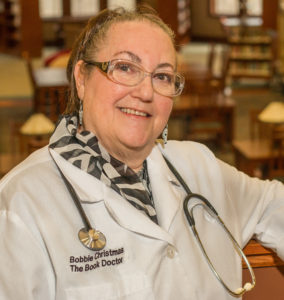 by Bobbie Christmas
by Bobbie Christmas
Q: I want to use TLC in dialogue (“Your sprained ankle could use some TLC.”) What is the proper way to write this? Also, how do I write ASAP? I know there are different rules for different abbreviations, but how do we know when to use hyphens between the initials or, as in NASA, use them as a word? TLC, like so many others, does not seem to fit any category.
A: ASAP, NASA, and TLC do, in fact, fit specific categories. NASA and ASAP are acronyms (words created from the initial letters of its elements) and TLC is an abbreviation (something spoken as letters, not a word). Acronyms often appear in all caps, but some have become so common that they became words. Scuba and snafu come to mind as examples of acronyms that have become words that are set in lower case.
As for abbreviations, CMOS shuns most abbreviations in narrative, with the exception of titles, such as Dr. Dialogue often ignores rules and guidelines, so while I wouldn’t use TLC in narrative, it’s fine in dialogue. We are accustomed to seeing both TLC and ASAP in all caps with no periods, so that’s how I would use it. Your example, “Your sprained ankle could use some TLC” is fine as is.
I don’t know of any reason to use hyphens between initials. Perhaps you mean periods, which I have seen at the end of some abbreviations. (Examples: St., oz., lb.) That said, if you’re writing a book, you should follow Chicago style and use such abbreviations only in specific cases, such as in charts or lists.
As if to confuse the matter more, some abbreviations have become commonly used as words and are lowercased, such as jpeg and pdf. When in doubt check the Merriam-Webster dictionary to see how best to format a specific initial or acronym.
Q: Should a pet’s name be capitalized in academic writing, such as Lassie, Toto, or other famous animal names? Also, what about a person’s own pets? Should these names be capitalized?
A: Pet’s names are proper nouns, which are always capitalized. Lassie and Toto are capitalized just as John and Mary are capitalized.
Although a pet’s name should be capitalized, its breed is not, but if part of its breed identity contains a proper noun, the proper noun is capitalized. Examples include German shepherd, Cairn terrier, and Labrador retriever.
Terms of endearment such as honey, sweetie, and cutie, which are sometimes called pet names—as opposed to pet’s names—are not capitalized unless they appear at the beginning of a sentence. Here’s an example: “Come here, sweetie, if you want your dinner.”
Q: I’m writing a book in which I use the names of board games (like Monopoly and Pictionary) and video games (like Rock Band and Guitar Hero). Do I need to use the TM or R symbol next to the names of those games within the pages of this book?
A: Can you imagine how unwieldy our writing would become if we had to use the trademark and copyright symbols every time we mentioned a registered product name? Although advertisements and packaging may use trademark symbols, authors of books follow Chicago style, and The Chicago Manual of Style recognizes registered names by capitalizing them only.
Ideally owners of trademarks also want us to use the generic description after the branded name, but that too can become cumbersome. For example, they wish we would say Kleenex brand facial tissues, Band-Aid brand bandages, and Jell-O brand gelatin. In most forms of writing, capitalizing games names such as Jell-O, Monopoly, or Guitar Hero is enough to acknowledge that the names are trademarked.
Bobbie Christmas, book editor, author of Write In Style: Use Your Computer to Improve Your Writing, and owner of Zebra Communications, will answer your questions, too. Send them to Bobbie@zebraeditor.com. Read more Ask the Book Doctor questions and answers at www.zebraeditor.com.
